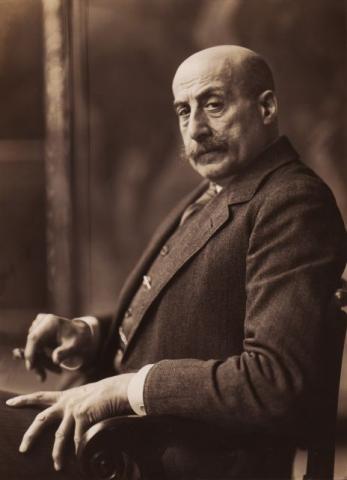The painter Max Liebermann, born in Berlin in 1847 as the son of the wealthy industrialist Louis Liebermann and his wife Philippine, née Haller, was one of the most important representatives of German Impressionism. Trained at the Grand Ducal Saxon School of Art in Weimar and after stays in Holland and from 1873 in Paris, Liebermann returned to Berlin in 1884, where he married Martha Marckwald in the same year. In 1885 their daughter Marianne Henriette Käthe was born. With his father's death in 1894, Liebermann became co-heir to a fortune worth millions, which enabled him to build up his art collection. From the early 1890s he collected prints by Rembrandt van Rijn and Honoré Daumier, as well as works by Carl Blechen and Adolph von Menzel. His collection of French Impressionists was of outstanding quality, with 16 paintings by Édouard Manet alone, including his famous asparagus bundle. Wilhelm Leibl's Bauernküche/Kücheninterieur from 1888, which the 44-year-old acquired at the Munich Annual Exhibition in 1891, is considered his earliest acquisition.
After the National Socialist rise to power in January 1933, Max Liebermann resigned his honorary presidency of the Prussian Academy of Arts in Berlin on 7 May 1933 in order to avoid the threat of expulsion on account of his Jewish origins. In order to protect himself from being seized by the Nazi regime, Liebermann, with the help of the art dealer Walter Feilchenfeldt, had fourteen of the most valuable paintings by French Impressionists deposited in the Kunsthaus Zürich in May 1933. Other mainly small-format paintings and drawings by Camille Corot and Daumier, among others, were subsequently taken abroad for sale. The majority of the art collection, however, remained in Berlin, in Liebermann's houses at Pariser Platz and Wannsee. After Liebermann's death on 8 February 1935, Martha Liebermann and her housekeeper moved to an apartment in Berlin's Tiergarten district in the fall of 1935. Due to worsening living conditions and anti-Jewish measures, she was forced to sell works of art, including Leibl's Bauernküche, which the Österreichische Galerie was to acquire from the Galerie Gerstenberger in Chemnitz in 1938. Despite the flight of her daughter Käthe Riezler and her family to the USA in 1938, she could not initially be persuaded to leave Berlin. All later efforts to escape to Switzerland or Sweden were thwarted by increasingly brazen demands for money and harassment by the Nazi regime. In 1942, for example, the prospect of leaving the country, which had already been held out, was ruined by the Nazi authorities' unfulfillable demand for foreign currency in the amount of 50,000 Swiss francs. After suffering a stroke in the winter of 1942/43, Martha Liebermann remained confined to her bed. To escape the threat of deportation to the Theresienstadt concentration camp, she committed suicide in March 1943. On 31 March 1943 the entire property was forfeited to the German Reich without compensation. The inventory and valuation of the art objects and movables remaining in Martha Liebermann's apartment took place on 24 July 1943, and their sale in September 1943 yielded proceeds of 84,191.40 Reichsmark, which were delivered to the Reich Treasury in March 1944.
In the context of the restitution proceedings conducted by Maria White, née Riezler, the granddaughter of Martha and Max Liebermann, in the post-war Federal Republic of Germany (FRG), the extensive research into the whereabouts of the works of art seized during the Nazi era remained without result. In June 1962, Maria White was awarded DM 170,075 in damages. In 2010, 2011 and 2012, the Prussian Cultural Heritage Foundation and the Federal Arts Administration of the FRG respectively restituted five drawings by Adolph von Menzel and an oil study attributed to Carl Blechen to the heirs. As a result of provenance research at the Österreichische Galerie, the Art Restitution Advisory Board recommended in May 2015 that the Leibl painting be transferred to the legal heirs of Martha Liebermann. With the restitution of Bauernküche in the same year, the first work of art acquired by Max Liebermann for his collection in 1891 passed to his great-granddaughters.

